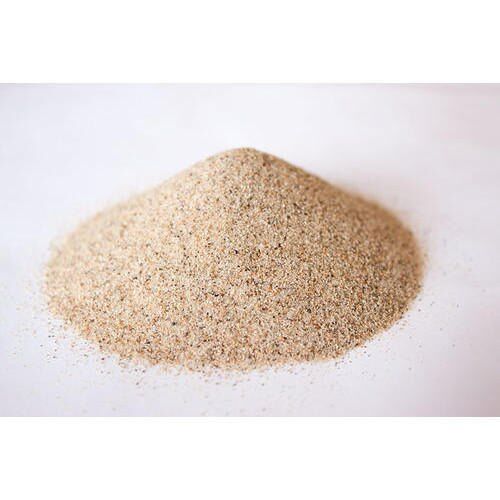Silica Sand (Brown)
Silica Sand, also known as brown sand, is a commonly used construction material with various applications.
Here are some of its main uses in construction:
Concrete Production: Silica sand is a key component in the production of concrete. It is mixed with cement, gravel, water, and other additives to create a strong and durable material. The silica sand helps provide the necessary strength, stability, and workability to the concrete mixture.
Mortar Production: Similar to concrete, silica sand is also used in the production of mortar. Mortar is a mixture of sand, cement, and water that is used to bind bricks, stones, or other building materials together. Silica sand helps improve the workability and bonding properties of mortar.
Brick Manufacturing: Silica sand is an essential component in the manufacturing of bricks. It is mixed with clay and other additives to form the brick mixture. The silica sand helps improve the strength and texture of the bricks, making them more resistant to weathering and erosion.
Road Construction: Silica sand is used in the construction and maintenance of roads and highways. It is often used as a base material for roadbeds and as a component in asphalt mixtures. The sand particles provide stability and drainage properties to the road surface.
Filtration Systems: Silica sand is commonly used in water filtration systems. It is an effective filter media for removing impurities and solids from water. Silica sand filters are used in swimming pools, wastewater treatment plants, and drinking water purification systems.
Landscaping and Paving: Silica sand is used in landscaping projects and for paving surfaces. It can be used as a decorative material in gardens, parks, and playgrounds. Additionally, it is used as a bedding material for pavers and as a joint filler between paving stones.
Sports Fields and Golf Courses: Silica sand is used as an infill material in artificial sports fields, such as soccer or baseball fields. It provides cushioning, stability, and traction to the playing surface. Silica sand is also used in golf course construction for bunker filling and top-dressing of fairways and greens.
Glass Manufacturing: Silica sand is a primary component in the production of glass. It is melted at high temperatures to form glass products, such as bottles, windows, and mirrors. The purity and consistency of silica sand are crucial for quality glass production.
Industrial Applications: Silica sand finds applications in various industrial sectors, including foundries, ceramics, abrasive blasting, and hydraulic fracturing (fracking) in the oil and gas industry. It is used as a molding and core material in foundries, as a raw material in ceramics, as an abrasive in sandblasting, and as a proppant in fracking to stimulate oil and gas production.
Apart from construction, brown silica sand has various other uses in different industries. Here are some notable applications of brown silica sand beyond construction:
Glassware and Glass Products: Brown silica sand is a crucial ingredient in the production of glassware and glass products. It is melted at high temperatures to form glass, which is then molded and shaped into a wide range of products such as bottles, jars, vases, windowpanes, and decorative glassware.
Ceramics and Pottery: Silica sand is extensively used in the ceramics and pottery industry. It is a key component in the production of ceramic tiles, sanitary ware, dinnerware, and decorative pottery. Silica sand helps provide strength, structure, and desired properties to the ceramic materials during firing.
Foundry Casting: Silica sand is widely employed in foundries for casting metal parts. It is used to make molds and cores that shape the molten metal into the desired form. The high heat resistance and thermal stability of silica sand make it ideal for foundry casting applications.
Filtration and Water Treatment: Silica sand, including brown silica sand, is commonly used as a filtration medium for water treatment processes. It effectively removes suspended particles, sediment, and impurities from water in various filtration systems, including swimming pool filters, water treatment plants, and industrial filtration units.
Abrasive Blasting: Brown silica sand is utilized as an abrasive material in sandblasting operations. It is propelled at high pressure through a blasting nozzle to clean and prepare surfaces, remove rust, paint, and other coatings, and provide a textured finish. Silica sand’s hardness and angular shape make it effective for abrasive blasting applications.
Oil and Gas Industry: Silica sand, particularly in the form of frac sand, is used in hydraulic fracturing (fracking) operations in the oil and gas industry. It is pumped into wells to keep fractures open, allowing the extraction of oil and natural gas from underground formations. Frac sand requires specific characteristics, including high purity and strength.
Sports and Recreation: Brown silica sand is commonly used in sports and recreational applications. It is utilized as infill material in synthetic turf systems for sports fields, providing cushioning, stability, and support. Silica sand is also used in sandboxes, golf course bunkers, and equestrian arenas for footing and drainage purposes.
Horticulture and Gardening: Silica sand can be used in horticulture and gardening applications. It is employed as a component in potting mixes to improve drainage and aeration. Silica sand can also be used for top-dressing lawns, improving soil structure, and promoting root growth in plants.
Industrial Manufacturing: Silica sand finds use in various industrial manufacturing processes. It is used as a raw material in the production of silicon and silicon compounds, which have diverse applications in electronics, solar panels, semiconductors, and other high-tech industries. Silica sand is also utilized in the manufacturing of abrasives, refractories, and ceramics used in industrial settings.
These are just a few examples of the diverse applications of brown silica sand in various industries beyond construction. Its unique properties make it a versatile material with wide-ranging uses.
It’s important to note that when handling silica sand or any construction material, appropriate safety precautions should be taken to minimize exposure to dust particles, as inhaling silica dust can pose health risks.
